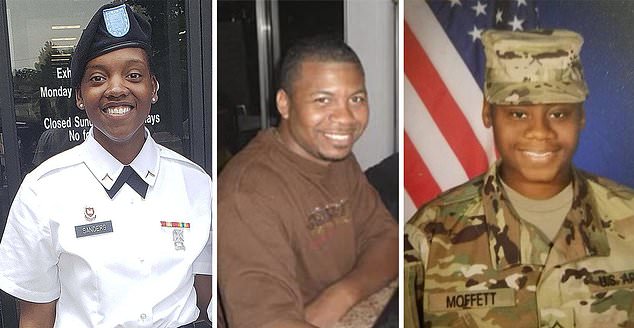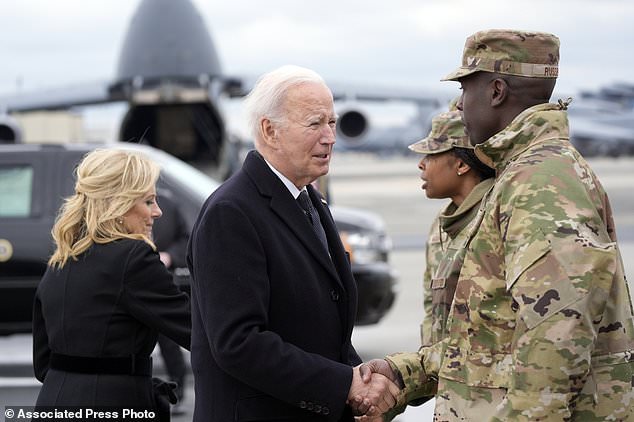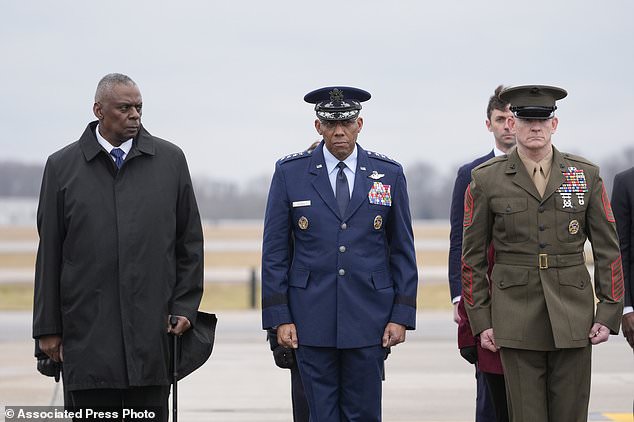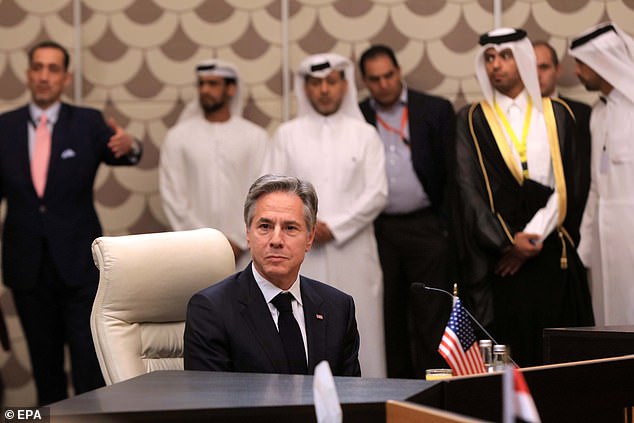US F18 fighter jets and warships strike at least 30 Houthi rebel targets across 10 locations as Iran-backed militants prepared to launch cruise missiles at ships in the Red Sea
The United States and Britain struck at least 30 Houthi targets in Yemen on Saturday in a second wave of attacks aimed at further eliminating Iranian-backed proxy militias.
Officials said cruise missiles were launched in response to moves by an Iran-backed rebel group preparing to attack more ships in the Red Sea, the day after the US also shot down at least eight drones in the region.
The latest strikes against the Houthis were also launched the day after an airstrike in Iraq and Syria that targeted other Iranian-backed groups and the Iranian Revolutionary Guards.
It marks an escalation of the conflict, in retaliation for the drone strike that killed three US troops in Jordan last weekend.
Officials told The Associated Press that the attacks targeted groups that have ruthlessly attacked American and international interests in the wake of the war between Israel and Hamas.
The Houthi targets were located in 10 different locations and were hit by U.S. F/A-18 fighter jets from the aircraft carrier USS Dwight D. Eisenhower and by U.S. warships firing Tomahawk missiles from the Red Sea, the U.S. officials said.
A satellite photo of a military base known as Tower 22, a Jordanian base that was targeted by a bomb-carrying drone that killed three American soldiers. The damage can be seen in the middle left of the photo

The strikes are in retaliation for the death of Spc. Kennedy Sanders, Sgt. William Jerome Rivers (center) and Spc. Breonna Alexsondria Moffett (right), who was killed on Sunday, January 28, 2024, by a drone strike on their base in Jordan, near the Syrian border
Saturday’s latest attacks come as the US military expands its presence in the Middle East, creating the potential for further conflict as it now wages wars on two fronts.
In addition to attacking the Houthis in Yemen, military leaders are also targeting Iranian allies who continue to attack US bases in Iraq, Syria and Jordan.
It comes after an Iraqi militia official on Saturday hinted at a desire to de-escalate tensions in the Middle East following the retaliatory attacks launched by the United States.
Hussein al-Mosawi, spokesman for Harakat al-Nujaba, one of the main Iranian-backed militias in Iraq, told The Associated Press that Washington “must understand that every action provokes a reaction.”
While condemning the US actions, the military official added that “we do not want to escalate or increase regional tensions.”
Mosawi said the targets in Iraq at the time of the attack were mainly “devoid of fighters and military personnel.”
Syrian state media reported casualties in the attacks, but did not provide figures. Rami Abdurrahman, head of the Britain-based Syrian Observatory for Human Rights, said 23 people, all regular fighters, were killed.

President Joe Biden and first lady Jill Biden greet service members before boarding Air Force One after attending a casualty return for the three service members killed in the attack

Defense Secretary Lloyd Austin (left), Chairman of the Joint Chiefs of Staff Gen. CQ Brown and Marine Corp. Sgt. Maj. Troy E. Black watches as an Army transport team moves the flag-draped transfer bin containing the remains of three service members killed in an Iran-backed attack

An army transport team loads the transfer case with the remains of the three military servicemen, whose deaths have sparked several waves of retaliatory attacks
Iraqi government spokesman Bassim al-Awadi said in a statement on Saturday that the attacks in Iraq near the Syrian border left 16 people dead, including civilians, and caused “significant damage” to homes and private property.
A US official said on Saturday that an initial battle damage assessment showed the US had hit every one of its planned targets, in addition to a few “dynamic targets” that emerged as the mission progressed.
These new targets include a surface-to-air missile site and drone launch sites. The official, who spoke on condition of anonymity to provide details that were not yet public, did not yet have an assessment of the number of victims.
The Iraqi Foreign Ministry announced on Saturday that it will summon the chargé d’affaires of the US embassy – the ambassador is outside the country – to hold a formal protest against US attacks on “Iraqi military and civilian sites.”
The US said on Friday it had informed Iraq of the impending attacks before they began.
The airstrike was the opening salvo of US retaliation for a drone strike that killed three US troops last weekend in Jordan. The US has attributed this to the Islamic Resistance in Iraq, a coalition of Iranian-backed militias.
Iran, meanwhile, has tried to distance itself from the attack, saying the militias act independently of their leadership.
Iraqi spokesman al-Awadi condemned the attacks as a violation of Iraqi sovereignty, especially as some of them targeted Population Mobilization Forces facilities.

US officials said they had informed Iraq of the impending attacks before they began on Friday. The photo shows US Secretary of State Antony Blinken
The PMF, a coalition of Iranian-backed militias, was officially brought under the umbrella of the Iraqi armed forces after joining the fight against Islamic State in 2014, but in practice continues to operate largely outside state control.
The Popular Mobilization Forces said in a statement on Saturday that one of the targets was an official security headquarters of the group.
In addition to the 16 deaths, 36 people are said to have been injured, “while the search for the bodies of a number of missing people is still ongoing.”
The Iraqi government has been in a delicate position since a group of Iranian-backed Iraqi militias calling themselves Islamic Resistance in Iraq – many of whose members are also part of the PMF – began carrying out attacks on US bases in Iraq and Syria on October 18 .
The group described the attacks as retaliation for Washington’s support for Israel in the war in Gaza.
Behind the scenes, Iraqi officials have tried to rein in the militias, while also condemning U.S. retaliatory strikes as a violation of Iraqi sovereignty and calling for the departure of the 2,500 U.S. troops in the country as part of an international coalition to combat IS. .
Last month, Iraqi and U.S. military officials launched formal talks to phase out the coalition’s presence, a process that will likely take years.
One of the main Iranian-backed militias, Kataib Hezbollah, said it was suspending attacks on US forces after Sunday’s attack that killed US troops in Jordan to avoid “embarrassing” the Iraqi government.
Meanwhile, the US military’s Central Command acknowledged on Saturday that it had had a series of skirmishes in the Red Sea and Gulf of Aden with Yemen’s Houthi rebels. On Friday, the USS Carney shot down a drone over the Gulf of Aden and there were no injuries or damage.
The US also carried out airstrikes on four Houthi drones as they were preparing to launch, which it said “posed an immediate threat to merchant ships and US Navy vessels in the region.”
On Saturday, Central Command said it had struck six additional anti-ship cruise missiles that it said it was prepared to launch and that posed an immediate threat.
Last night, F/A-18 fighter jets from the aircraft carrier USS Dwight D. Eisenhower, along with the USS Laboon, shot down seven drones in the Red Sea.
